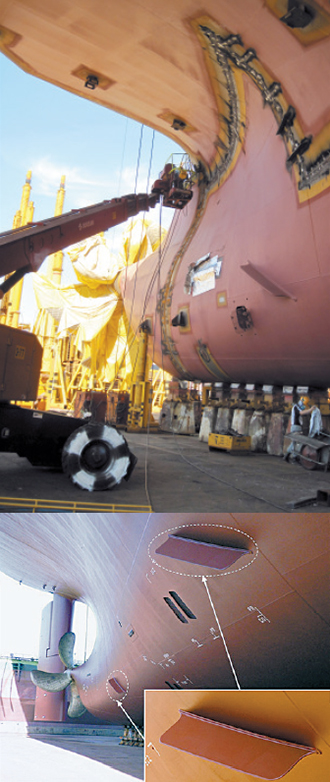Eco-friendly ships sail ahead

Two Saver Fins are attached to the body of an oil tanker, being built at the shipyard of Samsung Heavy Industries in Geoje, South Gyeongsang.Provided by the company
They are encouraging local shipbuilders to put forth more effort to develop fuel-efficient, “green” vessels.
From next year, the Energy Efficiency Design Index (EEDI) will be implemented to regulate gas-guzzling ships worldwide. The index indicates the amount of carbon dioxide emissions of a ship by number.
The International Maritime Organization has been discussing measures to slash carbon dioxide emissions exhausted by ships since 2008. It will impose even tighter rules from 2015, demanding a 10 percent cut in greenhouse gas emissions every five years for every ship.
Ships account for 3.3 percent of total global CO2 emissions, according to the organization.
Korean shipbuilders have increased fuel efficiency by 5 percent in recent years, but their technology to reduce fuel costs isn’t yet considered innovative, having a limited impact on the market.
Experts encourage them to keep making investments in research and development of green ships, forecasting that the invention of eco-friendly ships could be the key to easing the current financial crunch in the global shipbuilding market.
“Since the environmental regulation is expected to be a significant factor that can trigger a paradigm shift in the entire maritime world, the key question is who will be the first to develop the technology,” said Yang Jong-seo, a researcher at Overseas Economic Research Institute of Export-Import Bank of Korea.
“Korean shipbuilders are a bit late in this area, so they need to accelerate their efforts,” he said. “There will be an investment boom in green ships from 2015.”
The researcher said it would be a good opportunity for Korean shipbuilders to leave Chinese shipbuilders behind by developing unreachably high-standard technology.
Recently, cheaper Chinese ships have been a cause of oversupply of small and medium-size ships, triggering sharp falls in ship prices in the global market.
“As for container carriers, by increasing fuel mileage just by 2-3 percent, the prices of Korean ships would jump 10 percent compared to Chinese ships,” Yang said.
For tankers and bulkers, experts advise local shipbuilders to raise the current fuel mileage by 4-6 percent to be competitive.
“There will be a new competition over securing fuel-efficient vessels among shippers,” Yang said. “This could cause shippers to abandon old and gas-guzzling ships, which might help ease the current oversupply in the market.”
The world’s No. 1 shipbuilder Hyundai Heavy Industries unveiled last month the world’s first engine that could use liquid and gas fuel alternatively, which helps cut gas emissions.
The 35,600 horsepower dual-fuel engine can be used for all types of vessels, the company said.
“The company believes that the key is differentiation of technology in developing green ships,” said a spokesman at HHI.
In June, HHI operated the country’s first LNG-powered engine with capacity of 13,000 horsepower in trial mode. The engine cuts carbon dioxide emissions by more than 20 percent and nitrous oxide, a substance that is toxic to the air, by 97 percent, the company said.
Samsung Heavy Industries, the second-largest shipbuilder in Korea, is making efforts in a different way. It has been focusing on developing digital technology that will help cut fuel costs.
The company is promoting its Samsung Optimum Routing Assessment System. Soras searches for the shortest nautical course to cut down costs and time. Applying the system to an 113,000-ton oil carrier cuts the nautical time from Tokyo to Los Angeles by three hours and fuel consumption by 15 tons, according to the company.
SHI also promotes its Saver Fin, a piece of steel plate that just looks like the fin of a fish, being attached on the body of a vessel to reduce energy consumed to resist water pressure while sailing. Using the fins cuts fuel consumption by 5 percent, or 2 billion won ($1.84 million) in fuel costs per vessel, and vibration by 70 percent. Every ship developed by the company has the fins attached.
By Song Su-hyun [ssh@joongang.co.kr]










with the Korea JoongAng Daily
To write comments, please log in to one of the accounts.
Standards Board Policy (0/250자)